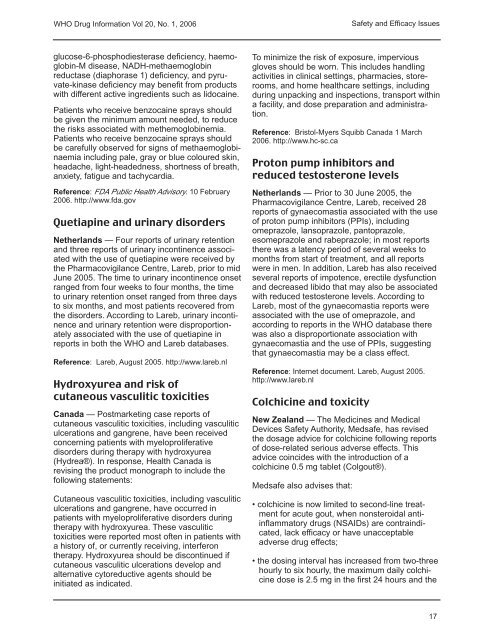WHO Drug Information Vol. 20, No. 1, 2006 - World Health ...
WHO Drug Information Vol. 20, No. 1, 2006 - World Health ...
WHO Drug Information Vol. 20, No. 1, 2006 - World Health ...
Create successful ePaper yourself
Turn your PDF publications into a flip-book with our unique Google optimized e-Paper software.
<strong>WHO</strong> <strong>Drug</strong> <strong>Information</strong> <strong>Vol</strong> <strong>20</strong>, <strong>No</strong>. 1, <strong>20</strong>06Safety and Efficacy Issuesglucose-6-phosphodiesterase deficiency, haemoglobin-Mdisease, NADH-methaemoglobinreductase (diaphorase 1) deficiency, and pyruvate-kinasedeficiency may benefit from productswith different active ingredients such as lidocaine.Patients who receive benzocaine sprays shouldbe given the minimum amount needed, to reducethe risks associated with methemoglobinemia.Patients who receive benzocaine sprays shouldbe carefully observed for signs of methaemoglobinaemiaincluding pale, gray or blue coloured skin,headache, light-headedness, shortness of breath,anxiety, fatigue and tachycardia.Reference: FDA Public <strong>Health</strong> Advisory. 10 February<strong>20</strong>06. http://www.fda.govQuetiapine and urinary disordersNetherlands — Four reports of urinary retentionand three reports of urinary incontinence associatedwith the use of quetiapine were received bythe Pharmacovigilance Centre, Lareb, prior to midJune <strong>20</strong>05. The time to urinary incontinence onsetranged from four weeks to four months, the timeto urinary retention onset ranged from three daysto six months, and most patients recovered fromthe disorders. According to Lareb, urinary incontinenceand urinary retention were disproportionatelyassociated with the use of quetiapine inreports in both the <strong>WHO</strong> and Lareb databases.Reference: Lareb, August <strong>20</strong>05. http://www.lareb.nlHydroxyurea and risk ofcutaneous vasculitic toxicitiesCanada — Postmarketing case reports ofcutaneous vasculitic toxicities, including vasculiticulcerations and gangrene, have been receivedconcerning patients with myeloproliferativedisorders during therapy with hydroxyurea(Hydrea®). In response, <strong>Health</strong> Canada isrevising the product monograph to include thefollowing statements:Cutaneous vasculitic toxicities, including vasculiticulcerations and gangrene, have occurred inpatients with myeloproliferative disorders duringtherapy with hydroxyurea. These vasculitictoxicities were reported most often in patients witha history of, or currently receiving, interferontherapy. Hydroxyurea should be discontinued ifcutaneous vasculitic ulcerations develop andalternative cytoreductive agents should beinitiated as indicated.To minimize the risk of exposure, imperviousgloves should be worn. This includes handlingactivities in clinical settings, pharmacies, storerooms,and home healthcare settings, includingduring unpacking and inspections, transport withina facility, and dose preparation and administration.Reference: Bristol-Myers Squibb Canada 1 March<strong>20</strong>06. http://www.hc-sc.caProton pump inhibitors andreduced testosterone levelsNetherlands — Prior to 30 June <strong>20</strong>05, thePharmacovigilance Centre, Lareb, received 28reports of gynaecomastia associated with the useof proton pump inhibitors (PPIs), includingomeprazole, lansoprazole, pantoprazole,esomeprazole and rabeprazole; in most reportsthere was a latency period of several weeks tomonths from start of treatment, and all reportswere in men. In addition, Lareb has also receivedseveral reports of impotence, erectile dysfunctionand decreased libido that may also be associatedwith reduced testosterone levels. According toLareb, most of the gynaecomastia reports wereassociated with the use of omeprazole, andaccording to reports in the <strong>WHO</strong> database therewas also a disproportionate association withgynaecomastia and the use of PPIs, suggestingthat gynaecomastia may be a class effect.Reference: Internet document. Lareb, August <strong>20</strong>05.http://www.lareb.nlColchicine and toxicityNew Zealand — The Medicines and MedicalDevices Safety Authority, Medsafe, has revisedthe dosage advice for colchicine following reportsof dose-related serious adverse effects. Thisadvice coincides with the introduction of acolchicine 0.5 mg tablet (Colgout®).Medsafe also advises that:• colchicine is now limited to second-line treatmentfor acute gout, when nonsteroidal antiinflammatorydrugs (NSAIDs) are contraindicated,lack efficacy or have unacceptableadverse drug effects;• the dosing interval has increased from two-threehourly to six hourly, the maximum daily colchicinedose is 2.5 mg in the first 24 hours and the17

















